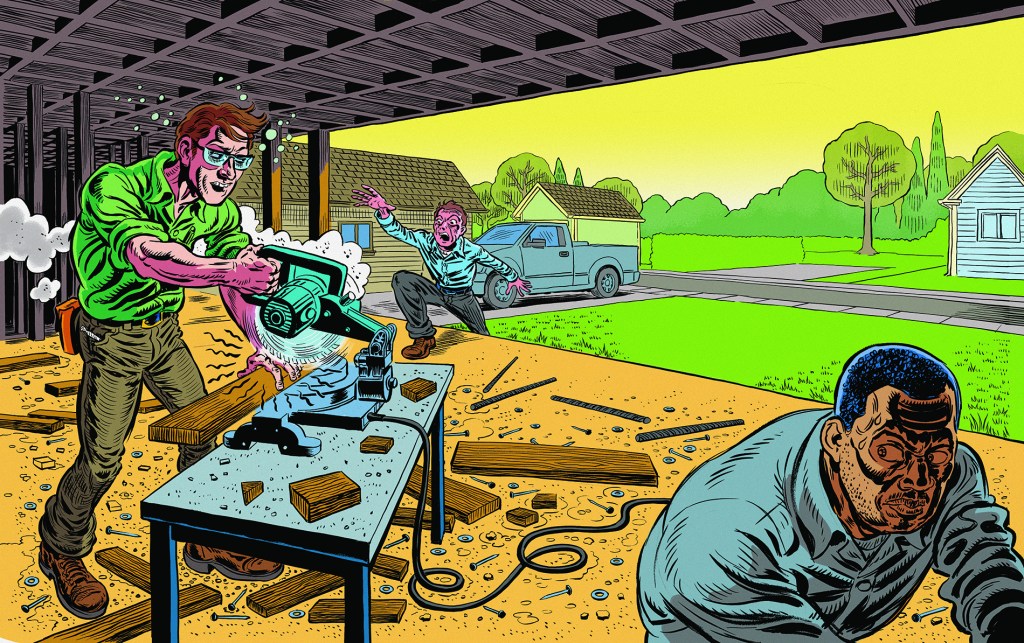Pardon the pun, but there’s a cloud hanging over remodeling business owners these days regarding marijuana.
An estimated 22.2 million Americans—that’s 8.3% of the whole country aged 12 and over—used marijuana in the previous month, according to a federal agency’s latest benchmark survey on substance abuse. Relaxed laws helped make that happen. So have generational differences; the use rate for those aged 18 to 25 (19.8%) is roughly triple that of adults 26 and over (6.5%).
A slew of data suggests this increase hasn’t led to more problems on the job. At the same time, fears about the drug’s potential impact—particularly in its new, more powerful state—have employers nervous.
“I’m very busy,” says Kathryn Russo, an attorney in Melville, N.Y., for the Jackson Lewis law firm who specializes in drug and alcohol testing. “Employers in every industry are confused and really don’t know what to do. The marijuana situation is worsening. It’s growing more confused by the day.”
Amid that uncertainty, one thing remains unchanged: Remodeling can be a dangerous business. So how much more dangerous is it when you have pot-smoking crew members who could get, as an owner put it, “one bubble off of level?” Our research found sharp contrasts in owners’ opinions on what’s the right thing to do in the workplace.
Many continue to maintain a no-drugs policy, saying it’s the best way to assure all remain safe (and, coincidentally, quell fears that workers’ comp rate hikes will rise). “Our policy is no illegal substances and no grace, you are fired,” declares Terry Albaugh of The Craftsmen Group, Wilmette, Ill. “It is not something I have had a problem with yet.”
Other remodeling company owners are like Tod Sakai, president of Sockeye Construction Corp., Kent, Wash. He says it’s none of his business whether his workers smoke marijuana at 7 p.m. on a work night. “But my expectation is that by 5 a.m. the next day, they need to be sober and ready to go,” he says. “[If I see] any risks to safety, I’ll immediately pull them. … I’m going to treat it just like alcohol: Effects should never be lingering at the site.”
And then there’s resigned acceptance by owners that they have to take in pot smokers despite the potential consequences because there’s nobody else left to hire. “Ninety-five percent of field workers test positive every time we test,” one remodeler says. “Before we were zero-tolerance, but we soon realized we wouldn’t have any workers, including some management.” And he’s based in Florida, a state that has yet to decriminalize pot.
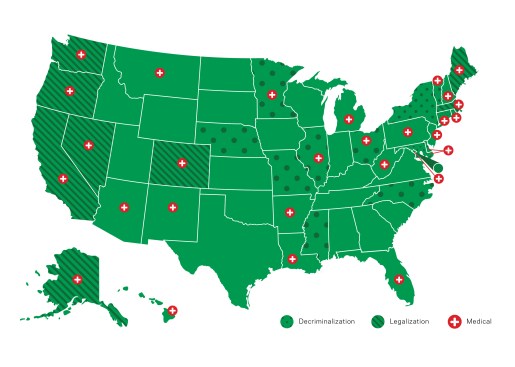
Data sourced from Norml.org
What’s Legal Where?
According to the National Organization for the Reform of Marijuana Laws (NORML), possession and personal use of marijuana is legal in eight states—Alaska, Washington, Oregon, Nevada, California, Colorado, Maine, and Massachusetts—plus the District of Columbia. Other states have cut criminal penalties for possession to misdemeanor levels. And marijuana can be used legally for medical purposes in 29 states and D.C. At press time, campaigns were under way in numerous states to permit its use for medical and/or recreational purposes.
Credit these changes to strong public support for legalizing marijuana. Numerous surveys reveal that strength; for instance, CBS News reported in April that 61% of Americans surveyed think marijuana use should be legal, up 5 points from last year, while 88% favor medical marijuana use.
About the only place where attitudes about marijuana are getting tougher is at the U.S. Department of Justice. There you’ll find Attorney General Jeff Sessions calling pot a “very real danger” and declaring “good people don’t smoke marijuana.” Federal rules on pot use apply for all commercial truck drivers. You can’t carry weed across state lines, even if both allow possession. Pot remains classified as a Schedule 1 drug, meaning it has no currently accepted medical use and carries a high potential for abuse. And the banking system is barred from serving the cannabis industry, which means that builders and building material suppliers in areas with robust marijuana businesses find themselves accepting huge wads of cash from customers.
“I don’t think America is going to be a better place when people of all ages, and particularly young people, are smoking pot,” the Huffington Post quoted Sessions as telling reporters in February. “I believe it’s an unhealthy practice, and current levels of THC in marijuana are very high compared to what they were a few years ago, and we’re seeing real violence around that.”
The clash within and between federal and state laws makes life tricky for employers. Many states’ statutes permitting marijuana use make clear that employers have the right to maintain a drug-free workplace. In Nevada, a court ruled that a person who had taken part in a drug rehabilitation program couldn’t claim a violation of the Americans with Disabilities Act when a drug test showed he had used pot. But in Rhode Island, a judge ruled that a fabrics company discriminated against a woman when it rescinded the offer of a paid internship because she participated in the state’s medical marijuana program and said she would be unlikely to pass the company’s mandatory pre-employment drug test. The Rhode Island judge said the woman’s civil rights were violated because the state’s medical marijuana law protects cardholders from discrimination in employment.
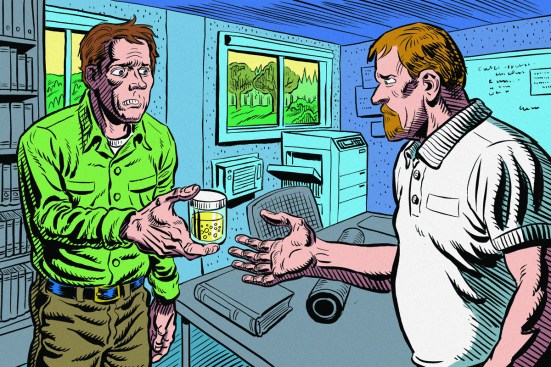
James Yamasaki
What’s the Fear?
You can detect pot use by examining a person’s urine, oral fluids, or hair. Quest Diagnostics does more than 10 million workplace drug tests annually.
Barry Sample, Quest’s senior director of science and technology, says the oral fluid test can spot THC (the primary intoxicant in marijuana) within about 36 hours of use, while urine testing is good for roughly 48 hours and the hair test reveals THC use in the past three months.
On urine tests—the most popular method—the positive hit rate for marijuana was 2.5% in 2016, Quest says. But in Colorado, where recreational use is allowed, the rate for urine tests increased to 2.9% in 2016 from 2.6% one year before. And Washington state, which also permits recreational marijuana use, saw its number of urine tests with positive results from marijuana rise to 3.1% of all cases in 2016 from 2.8% a year earlier.
The national hit rate implies that about one out of 40 workers uses pot. But Sample says so many people have figured out how to cheat on the urine test that he believes you should rely instead on the oral fluid test’s results. That one found the positive response rate for marijuana rose nearly 75% in 2016, to 8.9% of all tests from 5.1% in 2013.
Roughly 2.3 million Americans have medical marijuana permits, according to one ongoing tabulation by a pro-pot group. In both Maine and California, 3.8% of the population have cards.
And there aren’t just more users: What they’re using is more powerful. Research published in 2014 by the University of Mississippi’s National Center for Natural Products Research found that the percentage of THC in marijuana averaged 3% in the 1980s but had increased to 12% by 2012. Today, “you can easily find flowers well above 30% THC potency” in some states, the MerryJane.com blog reports.
Jo McGuire, co-chair of the Marijuana Outreach Committee of the Drug and Alcohol Testing Industry Association, toured a Colorado plant where the owner claimed his weed tested at 33%. “They’re GMO-ing this stuff to death,” McGuire says, using the acronym for genetically modified organisms.
Organizations like the National Institute on Drug Abuse say those high levels, plus the popularity of “dabbing,” in which one smokes or eats THC-rich hash oil, “raise concerns that the consequences of marijuana use could be worse than in the past.” Roughly 9% of people who use marijuana today become dependent on it, the institute says. “I definitely believe in gateway drugs,” McGuire says, “and I believe marijuana is more of a gateway than we’re used to.”
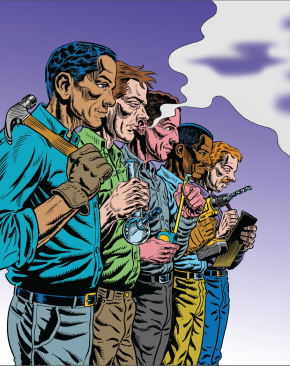
James Yamasaki
But How Bad Are Things Really?
The Rocky Mountain High Intensity Drug Trafficking Area (RMHIDTA), an anti-drug, government-funded agency, reports that Colorado’s ”marijuana-related” traffic deaths increased 48% in the 2013-2015 period compared with the previous three years, while all traffic deaths rose 11%. And annual visits to Colorado hospital emergency departments that are believed to be related to marijuana increased 49% in the two-year average for 2013 and 2014 compared with the 2011-2012 averages.
Those numbers may sound troubling, but a commentator for Forbes who’s far friendlier to pot than RMHIDTA notes “marijuana-related” traffic fatalities and hospitalizations only means pot was found in those people’s systems after the fact. It doesn’t verify that marijuana was responsible, Jacob Sullum writes. He suggests the increases on those counts could simply reflect an increase in both users and drug tests.
There’s also scant evidence the construction industry has been plagued by marijuana-induced accidents. Pinnacol Assurance, which handles workers’ comp coverage for 60% of all Colorado businesses, says claims have been dropping steadily in the state since 2011, the year before personal pot use became legal. Oregon, another permissive state, has had similar experiences. And an Oregon government agency’s study of workers’ compensation premium rates in every state finds the median comp rate nationwide in 2016 was virtually the same as it was two years before.
In 2009, the RAND Center for Health and Safety in the Workplace reviewed decades of academic studies on whether there’s a link between marijuana use and on-the-job injuries. It concluded that, yes, there is an association between substance abuse and on-the-job injuries, but it is “relatively small.”
RAND called harmful substance use “one of a constellation of behaviors exhibited by certain individuals who may avoid work-related safety precautions and take greater work-related risks.” Researchers call this group the “deviance-prone.”
It could also be that when people question marijuana use, they fixate on injuries. “Few studies look at the cost to industry of off-the-job worker injuries through disability and absenteeism,” the RAND report said. “This may, in fact, be a bigger concern.”
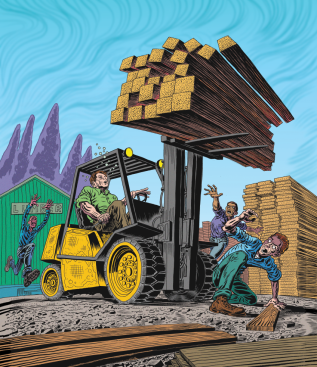
James Yamasaki
What’s the Good of Tests?
Case Design, the Bethesda, Md.-based giant, decided more than 10 years ago to introduce drug testing prior to employment as well as conduct tests randomly and in cases where it had reasonable suspicion.
“We had been having too many accidents over the past years and felt that this was a way to weed out some bad eggs,” says Jan Shaut, a senior vice president. “There was a lot of fear among our people, but our leadership group felt strongly that ‘clean living’ was more a part of our culture and that with the number of accidents we were having, we couldn’t afford to let those who were not drug-free work on jobsites.”
Since then, the number of accidents at Case has decreased, something Shaut also credits to increased safety efforts.
The problem with tests, experts say, is they can detect THC in a body long after the drug’s effects have worn off. The high produced from smoking marijuana starts with the first tokes, peaks in about an hour, and typically lasts three to four hours, though it still can impair as many as six hours later, according to guidelines issued in 2015 by the American Association of Occupational Health Nurses (AAOHN) and the American College of Occupational and Environmental Medicine (ACOEM).
As a result, tests that can detect that a worker smoked pot on Saturday night can’t establish if that employee was impaired on Monday morning. There’s no good breathalyzer or sobriety test for marijuana.
That’s partly why Wesley Crocket of Chicago-based Mahogany Builders, when asked whether his firm tests for marijuana, replied, “Not just no, hell no.” Aside from the fact that the tests for marijuana can’t prove a person was high on the job, Crocket says,
“I’d rather have a guy that smokes some pot after he gets off of work to chill out than a guy that hits the bar hard every night after work to let off some steam.” What people do just before starting work is another matter.
Tim Shigley, a remodeler based in Wichita, Kan., recalls one of his jobsites several years ago where he saw some electrical subcontractors lighting up in their car just prior to the day’s start. He called the subcontractors’ boss and made certain they didn’t do any work on his site that day. And an Oregon remodeler remembers well when a member of his team was toking with a coworker across the street from the shop, walked onto the job, and soon after cut off three fingers with a power saw.
A roofing company owner says he knew some local roofers who smoked in their work van so often that seeds that had fallen out of their joints had begun sprouting on the van’s floor.
“I would never tolerate an employee drinking a beer at lunchtime, and the same is true with marijuana,” says Zach Snider, principal at ALLOY, a Charlottesville, Va.-based architecture, construction, and graphic design firm. “Recreational drug use is for recreational time, not vocational time.”
Should You Keep Testing for Pot?
You are allowed to do so, and companies on federal contract are required to run a drug-free workplace. But in general, an increasing number of companies have stopped bothering. The Mountain States Employers Council found in a 2016 survey that 64% of 609 Colorado employers did pre-employment testing for marijuana, down from 77% in 2014.
On the other hand, McGuire believes it makes economic sense to keep testing. “According to the Labor Department, 40% of workplace fatalities are drug-related,” she says. “If there’s a serious accident, injury, a fatality, that’s going to cause a payout. Are you willing to absorb that 100% rather than allowing the possibility your employee might be at fault?”
Jackson Lewis attorney Russo says firms with dangerous workplaces should keep testing for marijuana. “But if you get a positive result and [the prospect has] a medical marijuana card, consult with your lawyer.” For those who don’t have a card and test positive, you can deny employment, she says.
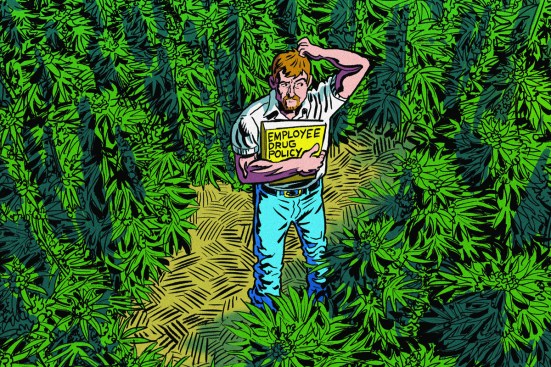
James Yamasaki
How to Start
At the very least, ACOEM and AAOHN say, “The best practice for employers is to begin with a clear written policy regarding chemical use and impairment.” As part of this effort, you may need to be able to call on a medical review officer; that’s a physician who can assess a candidate’s fitness for duty.
Do these things as well:
- If you don’t tolerate marijuana use by anyone at any time, be willing to conduct random tests of current workers.
- Consult a lawyer who knows state employment law.
- Keep up with current and prospective rules on pot. (NORML.org has state-by-state listings.)
- Decide whether you want to require employees in “safety-sensitive” positions to tell their supervisor about medical marijuana use.
- Tell employees whether you have the right to conduct searches.
- And make sure workers know the consequences of violating policies—particularly if they fail a drug test and especially if they don’t have a medical marijuana card.
“I really, really believe in second chances and rehab so that people can work successfully,” McGuire says. “I don’t believe everyone who uses drugs is an addict. I think employers have a real opportunity to contribute something positive to the culture and say, ‘You know what, there are healthy boundaries and you have to be safe and use common sense.’ … We have to stop thinking in extremes and behaving as if the extremes are the only option.”
What Else Can You Do?
Above all, be vigilant. Either you or the local supervisor should visit the jobsite first thing and scan the workforce for signs of impairment. Use your eyes, ears, and nose to detect warning signs.
“Our company custom is that field employees are largely interviewed and hired by their peers [e.g., carpenters and superintendents are interviewed and hired by the rest of the carpenters and superintendents] within the company,” says Mark Scott, owner of the Washington, D.C., area’s Mark IV Builders. “We find they do a better job at interviewing and mentoring their peers than most of the upper management. They certainly do a better job holding each other’s feet to the fire than the owners do.”
Second, show you care.
“With my own company, I don’t believe anybody has any issue [with drugs],” Sockeye Construction’s Sakai says. “Part of the reason why I know with my guys is that—and this isn’t a cliche—they are my family. I am the employer and they’re the employee, but I can be joking around just like any other guy on the jobsite. And, having that relationship, if they’re going to have surgery on their toe, I’ll say, ‘Don’t get that Percocet crap. Take Tylenol for a few days.’ We have that relationship, and the guys have that themselves; they count on each other.
“At the end of the day, I still care about the human interaction level, and if you care about them you’ll ask,” Sakai adds. “Doing that each day is so important.” Third, separate politics from safety. You may face intense pressure from workers to not interfere with their personal time, but most laws affirm that what your crews do privately can’t get in the way of their work for you.
Rethinking Reefer Madness
You could argue that employers should chill over pot use and worry more about liquor. (And painkillers; see related story) The National Institutes of Health says 27% of adults engaged in binge drinking in the past month during 2015; in contrast, 6.5% used marijuana in the same period.
As for direct impact on workplace productivity, the privately funded National Council for Alcohol and Drug Dependence says at least 11% of workplace fatalities had been drinking, and breathalyzer tests detected alcohol in 16% of ER patients injured at work.
What makes these times different for marijuana, perhaps, could lie in both labor trends and a generational gap. Let’s start with labor.
Time was, if you didn’t like drunks or stoners, there were enough people looking for work that you didn’t sweat finding job candidates who were clean and sober. But when the unemployment rate is as low as Colorado’s—just 2.3% in April vs. the national rate of 4.4%—and our nation has this century’s lowest ratio of job-seeking people to job openings, something’s gotta give.
A Minneapolis-based remodeler said his firm stopped pre-employment tests two years ago because it was too hard to find drug-free employees. He concedes that it hurts remodeling’s reputation when owners waive tests “just to get a body in the position at all costs.”
Gary Demos, president of Dave Fox Design-Build Remodelers, in Columbus, Ohio, says that so far his company has held the line on drug use, “and I hope that we won’t be forced to re-evaluate.” Dave Fox has drug-tested for the past 15 years, both prior to employment and then randomly. It has fired people for failing the test.
Mahogany Builders’ Crocket sees things differently. “Younger generations embrace marijuana in far greater numbers than their predecessors and are increasingly turning away from alcohol,” he says. “Who the hell are we to be discriminatory in such a way?”
Lots of baby boomers likely viewed their first experiences with smoking pot as acts of defiance against the over-the-top attitudes that inspired the 1936 cult film “Reefer Madness.” To those boomers, getting stoned was about enjoying the trip, not escaping physical pains or the anxieties of life. Those benefits didn’t get noticed until much later, when smokers were aged enough to have pains and be anxious.
At the same time, attitudes about personal freedom have evolved. And so with marijuana today, as a 1974 Doobie Brothers album cover put it, “What Were Once Vices Are Now Habits.” Where we go next is a trip that we’re all likely to be on for quite a while.
+++
See also:
* Resources to help address drug use in the workplace
* How opioids affect the construction industry
